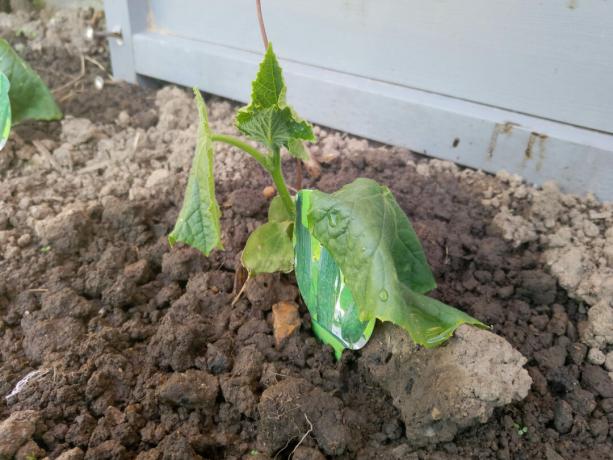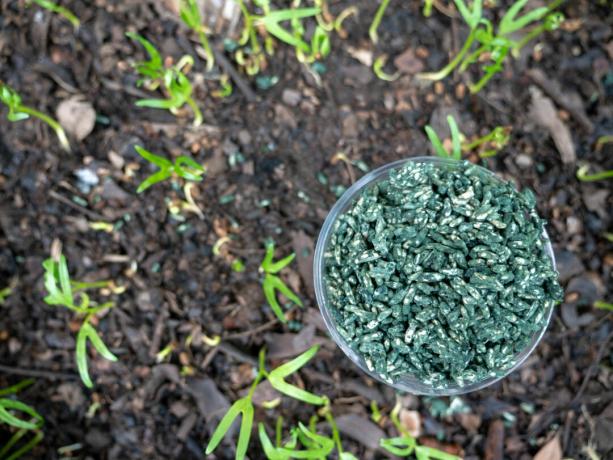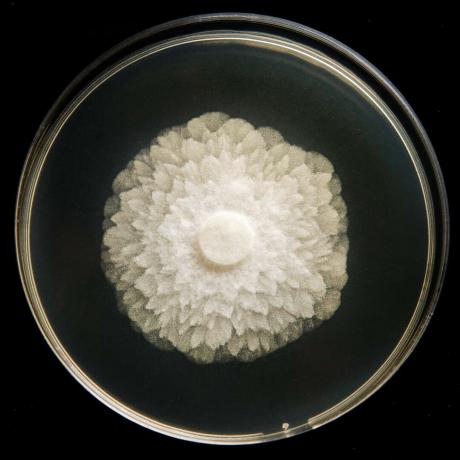Pythium is an egg fungus that can damage plant roots and even lead to the death of the plant. We'll show what you can do about Pythium.

The names root rot or black-legged refer to the same thing as pythium. A soil-borne, fungus-like pathogen that causes rot in our garden favorites. Everything you should know about this "fungus" and how you can fight and get rid of it can be found here.
contents
- Pythium: way of life and life cycle
-
Pythium: damage and symptoms in plants
- Pythium on the pea
- Pythium on cucumber, melon, pumpkin, zucchini and tomato
- Pythium on the parsley
- Pythium on the carrot
- Pythium on celery
- Pythium on lettuce
-
Pythium: what to do
- "Pythium: Combat Biologically"
- "Pythium: Combat Chemically"
- Avoid Pythium successfully
- Pythium or Phytophthora: The Difference
Pythium: way of life and life cycle
Pythium belongs to the order of the Oomycetes and the family Phytiaceae and has a very wide host range. Pythium is a so-called egg mushroom or dummy mushroom. Egg mushrooms are actually more closely related to algae than to real mushrooms, including plant diseases such as
Phytophthora infestans or the wrong one mildew. The egg fungus prefers moist soils with a low oxygen content, which is why plants on soils that tend to waterlogging are particularly threatened by Pythium. Depending on the stage of development of the egg fungus, the germination of the spores and the subsequent infection can occur a host plant is also favored by cooler temperatures (10 to 17 ° C) and periods of low light will. The egg fungus is one of the typical pathogens of emergence diseases. Emergence diseases often cause the seedlings to tip over or die before they even break through the surface. The following conditions favor the occurrence of Pythium:- Water-saturated, moist soils
- Low oxygen content
- Soil compaction
- High pH
- Lack of light
- Day temperatures over 30 ° C and night temperatures over 20 ° C

The Pythium development cycle
The egg fungus develops in two phases: In the first, sexual reproduction takes place and oospores are formed. These thick-walled oospores are designed to survive in unfavorable conditions. These permanent spores survive in the soil, in plant tissue or in water and can also stick to garden tools. When the conditions of development improve, the second phase of development, that of growth and diffusion, begins. The permanent spores of the egg fungus then form so-called swarm spores. The host plants look for these spores and penetrate the roots through injuries or soft elongation zones. There is a strong increase there. If the roots dry out, the egg fungus dies and persistent spores form. These can then germinate again under favorable conditions. This egg fungus can only occur in the ground or in subterranean parts of plants. Favorable conditions for swarm spores are at temperatures of 10 - 17 ° C and for permanent spores 25 ° C in combination with moisture.
Pythium: damage and symptoms in plants
Like all root diseases, Pythium causes wilting, yellowing, stunted growth and brown rotten roots. The roots get rotten from the root tip and the bark peels off. You can even strip the bark from the roots so that only so-called “rat tails” are left, i.e. the inner part of the root.

However, a special feature of Pythium ultimum is that the infestation causes egg constriction in the area between the root and the stem. This area usually turns brown, with cuttings the base turns black and they tip over. This is where the name Schwarzbeinigkeit comes from. Of course, it can also lead to a complete failure. The egg fungus can also attack the seedlings and prevent them from opening in the first place.
Onions become watery and rotten when infected. In the worst case, your plant will even die. Unfortunately, this happens because the rotten roots can no longer absorb any water or nutrients and their stability decreases.
Beware of confusion: there is also a strain of soil fungus that does not cause any damage, i.e. it is not pathogenic to plants. On the contrary, the M1 strain of Pythium oligandrum is an extremely helpful and approved plant tonic. The spores of this fungal strain are the active ingredient of the plant strengthening agent Polyversum and help against various fungal diseases. Pythium oligandrum suppresses other harmful fungi by feeding on them - hence it is also called a hyperparasite. The fungus colonizes the plants and increases their defenses against fungal infections. This remedy is particularly used against fusarium and root diseases.
Pythium on the pea
At the pea (Pisum sativum) the species P. ultimum., P. debaryanum, P. aphanidermatum and P. arrhenomanes before. The seedlings are damaged before emergence and then fall over. Older plants can also damage the roots. P. ultimum can also cause shoot tip burns in older plants. The tips look watery at first and then begin to dry up and die off. However, the whole pea plant rarely dies. High humidity and temperatures between 24 and 28 ° C have a beneficial effect.
Pythium on cucumber, melon, pumpkin, zucchini and tomato
Also on fruit vegetables such as cucumber, melon, pumpkin, zucchini and tomato can cause pythium seedling damage. Species P. aphanidermatum, P. debaryanum, P. myriotylum, P. ultimum and P. uncinulatum responsible.

However, stem rot can also be triggered by Pythium in these types of vegetables. The damage occurs after planting out. There is a glassy, gray-green discoloration of the base of the stem, which later turns brown. The stem constricts and begins to rot right between the soil and the cotyledons. This means that hardly any roots grow and the plants die within 2 weeks.
For tomatoes (Solanum lycopersicum) After planting out, a watery zone is created on the stem near the ground. This area then also constricts and causes the tomatoes to tip over. A lot of moisture and little light are particularly beneficial. The stem rot is caused by the Pythium species P. aphanidermatum, P. irregular, P. sylvaticum and P. ultimum caused.

Pythium on the parsley
If the parsley (Petroselinum crispum) falls over or wilts, Pythium may be the reason. Especially P. mastophorum is particularly aggressive with parsley, but P. ultimum, P. irregular, P. paroecandrum and P. sylvaticum can be the cause of damage. With parsley, too, there are constrictions on the stems of the seedlings and older plants that have already reached a height of 10 cm are attacked. Gray, brown or rust-brown spots appear on the roots. In the case of severe infestation, the side roots are even missing or only brown stumps remain. The parsley begins to turn yellow and eventually dies.
Pythium on the carrot
Root and tuber vegetables, like that carrot (Daucus carota) or radish (Raphanus sativus) are particularly threatened by Pythium root rot in waterlogged soils. The first signs show when the carrot is 10 to 15 cm in size. The carrots look limp during the day, but recover at night. The growth begins to stagnate and the leaves change color. Side roots are increasingly formed and the root tissue is soft and discolored rust-red.
Pythium water spot disease causes translucent and sunken infestation areas that can reach up to 5 mm deep on the beets. If you remove the epidermis from infected carrots, you can see black wart-like structures. This disease (cavity spot) is an important issue in carrot cultivation and is reported by P. violae and P. sulcatum causes.
Pythium on the celery
The seedling disease and root rot is when celery (Apium) by P. mastophorum and some other species. During cultivation, the seedlings wilt like nests and turn yellow. In addition, the cotyledons begin to fall off and the seedlings are compressed. Because their roots shrink, the seedlings can also be easily pulled out of the ground. The roots turn rusty brown, even in older plants, which rot as a result and ultimately die.
Pythium on the salad
Also at salad (Lactuca sativa) seedling diseases occur due to Pythium infestation (P. irregular, P. sylvaticum). The wilt with lettuce and endive (Cichorium endivia) is caused by Pythium in spring and autumn. In hot and dry weather, the damage caused by P. tracheiphilium. The lettuce has a reduced growth, if you cut through the head of the lettuce, you can see brown vessels. Necroses are visible on the petioles and the leaves may even turn yellow and die. The lettuce can be pulled out of the ground without the roots tearing off. These appear very necrotic.
Pythium: what to do
There are a few ways you can get rid of this dreaded fungus. For a long time, “hygiene” in the garden was the most important strategy to combat emergence diseases. Everything was made sterile and yet root diseases like Pythium found their way to the plants. We'll tell you which methods work better in the following section.
"Pythium: Combat Biologically"

Studies show that there are bacteria and fungi that are good opponents to soil-borne pathogens. Therefore these organisms can be used for biological control of Pythium. For example, you can use the hyperparasitic fungus Trichoderma harzianum. But also Gliaocladium sp. manages to displace the harmful fungus.
The biological fungicide Prestop can be used against various Pythium species on young plants, vegetables and ornamentals. It is applied by pouring or spraying. This biological fungicide is based on the hyperparasitic soil fungus Gliocladium catenulatum.
The agent has three mechanisms of action: It parasitizes the harmful fungus and kills it. The remedy also produces enzymes that suppress the growth of the fungus. The last mechanism of action works through competition. Due to its strong growth, the fungicide displaces the harmful fungus, as it deprives it of its habitat. Preparations with Trichoderma also work with this mechanism of action.
“Pythium: Combat chemically ”
For larger-scale cultivation, the seeds are often dressed with special agents to prevent fungal infection. Dressing means that the seeds are coated with a pesticide before they are sown - this protects them. However, such agents are not approved for household use.
Avoid Pythium successfully
The most important thing in avoidance and prevention is to control your location. Moisture is particularly beneficial for this egg fungus, so you should try to keep your garden dry and especially avoid flooding. If you have particularly heavy and moist soil, try adding sand or crushed stone to help drain the water.
As a preventive measure, compost soil can be used in the garden. In this soil there are often useful fungi that fight harmful organisms through competitiveness and parasitic behavior.
As already mentioned, a lack of light encourages the growth of Pythium. Therefore your crops in particular should always get enough light. Do not bring your darlings in a dark corner, but rather on a sunny window sill in clean planters. When growing plants, you can also pay attention to a few things to avoid the danger of a To reduce Pythium infection: The temperature should be 19 ° C, the healthy substrate must be as dry as to be possible. It is best to plant your little protégés in the evening. The irrigation water should not be too cold either. If you are using drip irrigation, be careful that the watering is not aimed directly at the stem.

You can also use plant strengtheners made from field horsetail (Equisetum arvense) use. The horsetail broth has a preventive effect against soil fungus and also serves as a tonic for our plants. Field horsetail manure can be used, especially with seedling diseases, and the potting soil can be poured over with the manure beforehand. To protect the plants from the soil fungus when they are released, you can give the seedlings a short root bath in field horsetail manure. For preventive and direct protection against fungi, you can also water the plants with this liquid manure in the morning.
Here you can find out more about field horsetail and its possible uses.
The prevention in a nutshell:
- Keep your garden beds dry and airy
- Use compost
- When growing plants:
- Enough light
- Clean growing containers
- Cultivation temperature approx. 19 ° C
- Do not pour too cold
- Plant out in the evening
- Field horsetail manure for plant strengthening (and fungus control)
Pythium or Phytophthora: The Difference

Pythium sp. and Phytophthora sp. both belong to the class of the Oomycetes and therein to the family of the Pythiaceae, but to different genera. However, these two fungi often occur as a mixed infestation. However, Pythium is less host specific than Phytophthora. Phytophthora is also more aggressive than Pythium, because Phytophthora can also attack and kill adult plants. Both fungi prefer damp soils with a low oxygen content and cause sowing to overturn and rot in the root area.

You cannot tell the two pathogens apart from the externally recognizable symptoms of rot. The exact differentiation can only be made by examining the spores of the fungi - especially since these pathogens have many different representatives, in different cultures for example Pythium ultimum or Phytophthora infefstans.
How yourself Phytophthora developed and what you can do against this fungus, you can find out here.



